#koder
Explore tagged Tumblr posts
Photo

Customer: MY NICKNAME FROM FRIENDS & FAMILY DMV: RED, GANG REFERENCE Verdict: ACCEPTED
#California license plate with text KODERED#bot#ca-dmv-bot#california#dmv#funny#government#lol#public records
87 notes
·
View notes
Text
KODER Première of the documentary “Serap Derim”
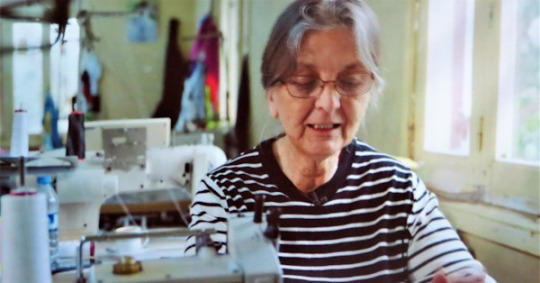
View On WordPress
0 notes
Text

Cochin Jewish ketuba, the certificate of the marriage of Haim Hallegua to Miriam Koder, in 1923 - witnesses Abraham Cohen and Reuben Hallegua.
photo from India’s Jewish Heritage: Ritual, Art, & Life-Cycle, courtesy of Samuel H. Hallegua, author of the chapter, "The Marriage Customs of the Jewish Community of Cochin."
#judaism#jewish#jumblr#jewblr#art history#jewish art history#jewish history#ketubah#art#cochin#cochin judaism#jewish art
312 notes
·
View notes
Text
besede dne: šalobárda (nespameten, neumen človek; menda tudi nekdo, ki je nemožat in nezanesljiv), šalobárditi (brezciljno pohajkovati, obnašati se trapasto) in šalobárdast (nemožat, raztresen, neroden, brez značaja)
etimologija: Pleteršnik, od katerega sicer pobiram tudi večino definicij besed zgoraj, pravi oziroma implicira, da so besede morda prevzete prek bavarske nemščine (Schalbart). A vas tukaj zanima nekaj kulskega? :D :D :D :D
Takole pravi Pleteršnik:

Zato grem pač iskat slovar bavarščine in najdem tole beštijo iz leta 1877, ki jo na žalost zaradi črk komaj znam brati, ampak mi je pa vseeno uspelo najti tole:

Sicer bi težko rekli, da mi kaj grozno pomaga, ampak me je pa tako zelo razveselilo!! Primarni vir 💃💃🕺🕺🥳🥳🥳🥳!!! (Se mi zdi 😅)
Gemacht Antliz bi v teoriji moralo pomeniti "narejen obraz", ne? Kar jaz v kontekstu, ki ga dobite čez nekaj odstavkov, interpretiram kot šemasto masko za obraz, ampak me lahko germanisti in vsi, ki nemško dejansko znate, kar popravite.
Naslednji in poslednji namig, ki nam ga da Pleteršnik:

Gesicht, to poznamo, to je ksiht, obraz. Larve pa naj bi kot arhaizem pomenilo tudi "maska". No, to niti ni tako važno — najpomembnejši je prvi delček Pleteršnikovega namiga, srednjevisokonemški Schembart! In z njim bomo tudi zagrizli v dejansko jedro tele objave :D !!
V Nürnbergu je od sredine 15. st. do začetka/zgodnje sredine 16. st. v dneh pred pustnim torkom potekal poseben karneval, der Schembartlauf. Nemška Wikipedija pravi:
iz srednjevisokonemškega [der] schëm(e), "senca, maska", schëmbart "bradata maska", po ljudski etimologiji Schönbart (lepa brada?), od koder tudi Schönbartlauf
O tem karnevalu govori vsak malo po svoje, meni pa zgodovina nikoli ni šla, tako da mi poglejte malo skozi prste, lepo prosim 😅. Toplo priporočam, da si več preberete sami in mi ne pustite, da vam kaj narobe povem!!
Načeloma naj bi šlo za nekakšno nagrado mesarskemu cehu, ker se ni pridružil uporu cehov, ampak ta zgodba je malo vprašljiva. Imeli so pravico do plesa na karnevalu v predpostnem času, pred njimi pa so menda tekali in jim delali prostor najprej najeti "tekači", potem pa plemiči, ki so si kupili pravico do sodelovanja: Schembartläufer (je smiselno potegniti etimološko vzporednico s cerkljanskimi laufarji?). Z njimi so kostumi postali dražji in bolj ekstravagantni, pisani in glasni — pogosto so namreč okrog pasu in kolen nosili zvončke!
Pozneje so dodali tudi vozove (Höllen, ampak tu me pa nemščina res zapusti, ker ne vem, kaj bi bilo to drugega kot "pekli") pod podobo gradov, zmajev, ladij, velikanov ... Vlekli so jih konji ali sami tekači/šeme. Imeli so pa tudi ognjemete in streljali lutke iz topov ali jih dajali jesti velikanom na vozovih.
Tudi drugi, ne samo Schembartläuferji, so na karnevalu nosili maske in zganjali karneval kraval: tekli za ljudmi, vpili, metali okrog pepel, perje, grdo govorili in grdo rimali ...
Seveda dobite kup slik (pogosto na ilustracijah šeme držijo v rokah simboličen kup listja in vej, ki je sicer videti grozno artičokast):
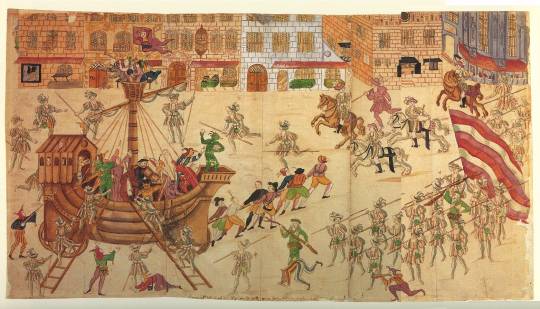
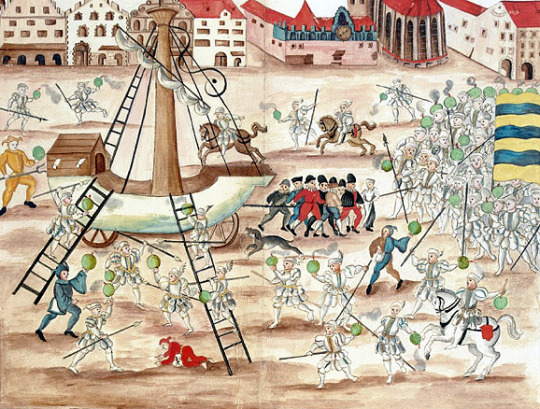
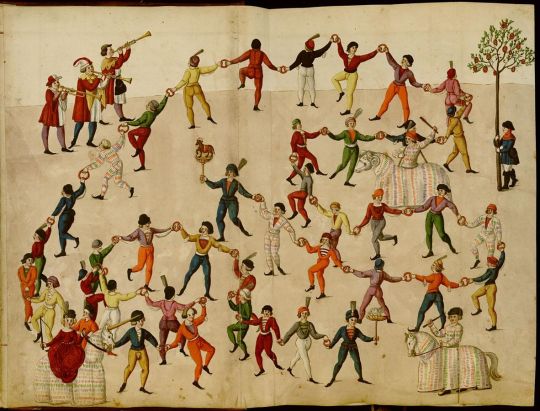
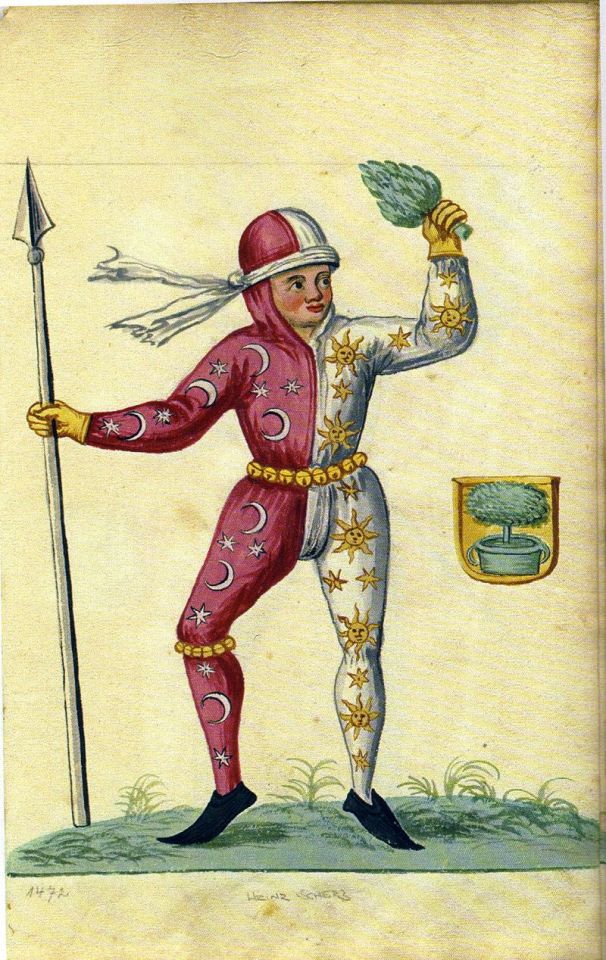

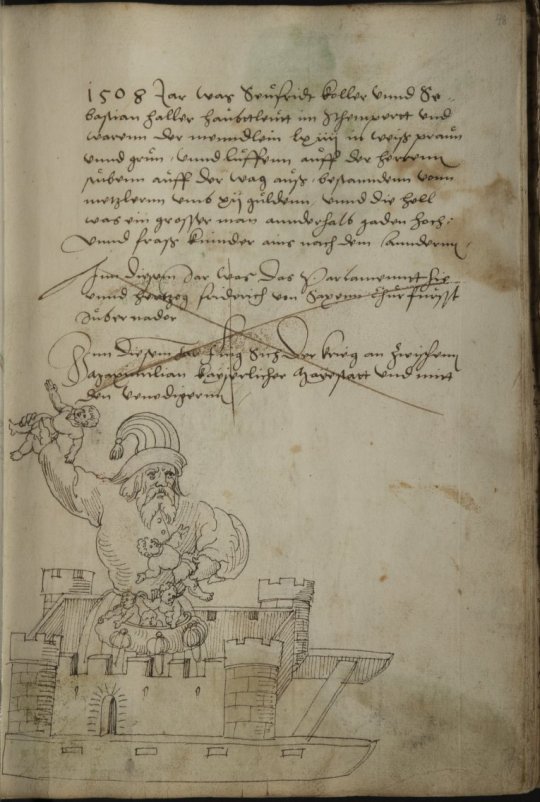

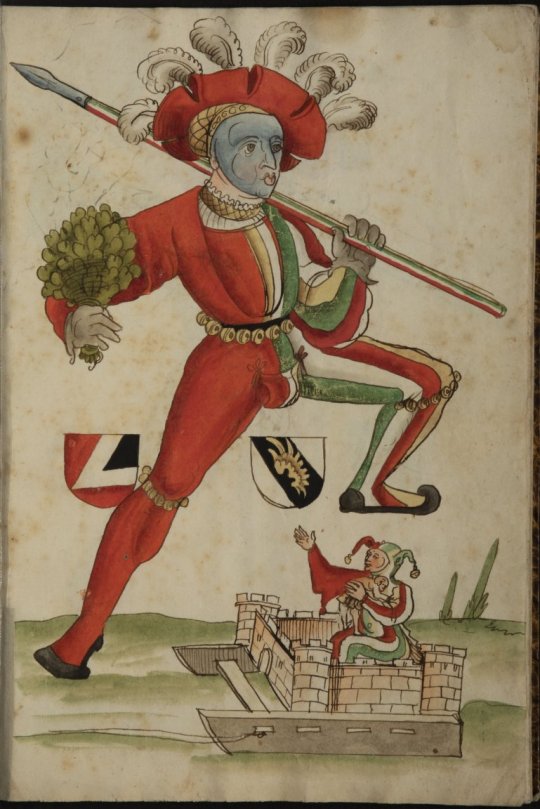

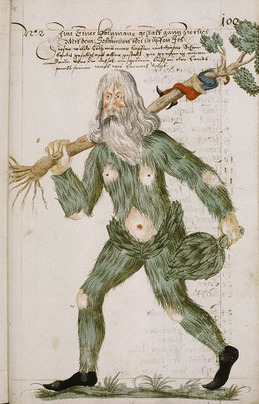
Leta 1539 so po večletni prekinitvi karnevalov zaradi izbruha kuge festival spet priredili. Protestantizem je takrat v Nemčiji dobival zagon, protestantje (med katerimi je bil tudi Andreas Osiander, očitno nek pomembnejši luteranski teolog) pa so karnevalu nasprotovali. Leta 1539 je bil karnevalski voz torej okrašen kot ladja, na katero so med peklenščke in norce postavili kip Osiandra. O njem so peli zbadljive pesmi in mu skušali vdreti v dom — no, to je bilo zadnje leto, ko so karneval še smeli prirediti 😅.

Od 1974 ga pa sicer spet obujajo! :D
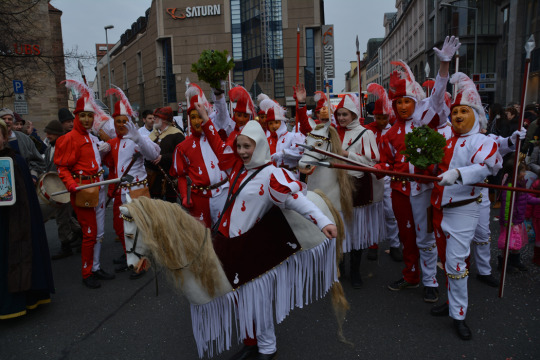
Etimološka ideja je torej taka: mislim, da pride naša "šalobarda" iz srednje visoke nemščine s pomenskim premikom od nekakšne šeme do norčka, nekoga, ki se obnaša trapasto. To bi bilo še kar smiselno, ne? Če se motim, bom pa dvorni norček danes jaz 😅🤡!
Viri:
Bayerisches Wörterbuch, s. v. "der Schalbart", avtor Johann Andreas Schmeller, 1877. Str. 394 v knjigi oz. 225 v pdf-ju. https://www.bavarikon.de/object/bav:BSB-MDZ-00000BSB11351207?p=225 <- Pleteršnikov vir, se mi zdi! Sicer ime slovarja tukaj krajšam, ker je v resnici dolgo za par odstavkov
"Masks, Hells, and Books: The Nuremberg Schembartlauf (1449-1539)". (n. d.). University of Missouri. Obiskano 21. 6. 2025. https://library.missouri.edu/specialcollections/exhibits/show/schembart/introduction <- dober vir!
"Schembartlauf". (2024). Wikipedia, die freie Enzyklopädie. Obiskano 21. 6. 2025. https://de.wikipedia.org/w/index.php?title=Schembartlauf&oldid=250238512
"Schembart books". (2009). Christie's. Obiskano 21. 6. 2025. https://www.christies.com/en/lot/lot-5214140 <- ne nujno ravno dober vir. Opis, ki ga je dražbena hiša dodala knjigam o tem karnevalu, ki jih je prodajala.
"Schembart Carnival". (2025). Wikipedia, the free encyclopedia. Obiskano 21. 6. 2025. https://en.wikipedia.org/w/index.php?title=Schembart_Carnival&oldid=1294901262
Slovensko-nemški slovar, s. v. "šalobȃrda", avtor Maks Pleteršnik, obiskano 21. 6. 2025, https://www.fran.si/136/maks-pletersnik-slovensko-nemski-slovar/4071800/salobrda
Slovensko-nemški slovar, s. v. "šalobárdast", avtor Maks Pleteršnik, obiskano 21. 6. 2025, https://www.fran.si/136/maks-pletersnik-slovensko-nemski-slovar/4071801/salobardast
Slovensko-nemški slovar, s. v. "šalobárditi", avtor Maks Pleteršnik, obiskano 21. 6. 2025, https://www.fran.si/136/maks-pletersnik-slovensko-nemski-slovar/4071802/salobarditi
SSKJ2, s. v. "šalobárda", obiskano 21. 6. 2025, https://www.fran.si/133/sskj2-slovar-slovenskega-knjiznega-jezika-2/4536959/salobarda
Sumberg, L. S. (1941). "The Nuremberg Schembart Carnival". <- meni osebno je zmanjkalo časa in motivacije to kaj dosti brati (🙁), ampak mislim, da bi bil lahko res soliden vir, zato dodajam na seznam za vse, ki vas bi potencialno zanimal!
Weisman, S. H. (2010). "The Nuremberg Schembartlauf and the Art of Albrecht Dürer". Cerise Press. Obiskano 21. 6. 2025. https://www.cerisepress.com/01/03/the-nuremberg-schembartlauf-and-the-art-of-albrecht-durer
Wiktionary, s. v. "Larve", obiskano 21. 6. 2025, https://de.wiktionary.org/wiki/Larve <- angleški Wiktionary arhaičnega pomena ni imel, ampak še dobro, da se mi je uspelo spomniti, da je pametno pogledati potem na nemškega :D !
Slike (citirane po vrstnem redu, v katerem so v objavi):
Voz — ladja z zelenimi peklenščki, ki gre proti sprevodu vojščakov: "Schembartlauf". (neznan datum, verjetno med 1540 in 1800). [ilustracija]. Wikimedia Commons. Obiskano 21. 6. 2025. https://upload.wikimedia.org/wikipedia/commons/thumb/6/6e/Schembartlauf.jpg/1200px-Schembartlauf.jpg?20051229014035
Voz — ladja brez zelenih peklenščkov, ki jo napadajo vojščaki: iz članka Stefanie H. Weisman: "The Nuremberg Schembartlauf and the Art of Albrecht Dürer". (n. d.). [ilustracija]. Obiskano 21. 6. 2025. https://www.cerisepress.com/wp-content/gallery/issue-3-essay-stefanie-hava-weisman-the-peasant-and-his-wife-at-the-market/from_the_nuremberg_schembart.jpg
Plešoče šeme: "Šeme plešejo kolo". (n. d.). [ilustracija]. Wikimedia Commons. Obiskano 21. 6. 2025. https://upload.wikimedia.org/wikipedia/commons/thumb/c/c9/Schembartbuch_UB_of_California_Coll._170_Ms_351_001.jpg/1182px-Schembartbuch_UB_of_California_Coll._170_Ms_351_001.jpg?20110321172938 <- ime sliki dajem jaz, ker ne najdem nikjer bolj uradnega 😅
Šema v rdeče-beli opravi: "Schembartlauf 1472". (1. polovica 17. st.). [ilustracija]. Iz dela Dominika Radlmaierja: "Handschriften der Welser", 2008. Wikimedia Commons. Obiskano 21. 6. 2025. https://commons.wikimedia.org/wiki/File:Schembartlauf_1472.jpg
Voz pod podobo zmaja: "Voz iz 1475". (n. d.). [ilustracija]. Masks, Hells, and Books: The Nuremberg Schembartlauf (1449-1539). University of Missouri. Obiskano 21. 6. 2025. https://library.missouri.edu/specialcollections/files/fullsize/c0e5d8985e72d638b67cd776f8aa6dc5.jpg
Voz pod podobo velikana, ki žre ljudi: "Voz iz 1508". (n. d.). [ilustracija]. Masks, Hells, and Books: The Nuremberg Schembartlauf (1449-1539). University of Missouri. Obiskano 21. 6. 2025. https://library.missouri.edu/specialcollections/files/fullsize/5bc1773e655670cefd90e05e995d25f8.jpg
Šema v zeleno-rumeni obleki: "Läufer iz 1507". (n. d.). [ilustracija]. Masks, Hells, and Books: The Nuremberg Schembartlauf (1449-1539). University of Missouri. Obiskano 21. 6. 2025. https://library.missouri.edu/specialcollections/files/fullsize/bf68bde01dc38c62d11fe3e7ab6bca42.jpg
Šema v rdeče-zeleni obleki: "Läufer iz 1524". (n. d.). [ilustracija]. Masks, Hells, and Books: The Nuremberg Schembartlauf (1449-1539). University of Missouri. Obiskano 21. 6. 2025. https://library.missouri.edu/specialcollections/files/fullsize/a2be4cf4329e571b96392930ac13f9b1.jpg
Šema z medvedjo dlako in prašičjo glavo: iz članka Stefanie H. Weisman: "The Nuremberg Schembartlauf and the Art of Albrecht Dürer". (n. d.). [ilustracija]. Obiskano 21. 6. 2025. https://www.cerisepress.com/wp-content/uploads/2009/07/pig_from_nuremberg_schembart.jpg
Gozdni mož: iz članka Stefanie H. Weisman: "The Nuremberg Schembartlauf and the Art of Albrecht Dürer". (n. d.). [ilustracija]. Obiskano 21. 6. 2025. https://www.cerisepress.com/wp-content/uploads/2009/07/wildman_nuremberg_schembartlauf.jpg
Voz z Osiandrom: "Voz iz 1539". (n. d.). [ilustracija]. Masks, Hells, and Books: The Nuremberg Schembartlauf (1449-1539). University of Missouri. Obiskano 21. 6. 2025. https://library.missouri.edu/specialcollections/files/fullsize/4d82ec505f36bff155088d91e32428a8.jpg
Moderni karneval: "Schembartlauf v Nürnbergu". (2016). [fotografija]. Medieval Histories. https://www.medieval.eu/wp-content/uploads/schembartlauf-web.jpg
#moram se pa res naučiti nemško¸ mejduš#tole je bilo zabavno! ampak nikar ne vprašajte¸ koliko ur je vzelo¸ ker mi bo nerodno XD#(#fran+#)#sicer je Pleteršnik že vse naredil¸ tako da si oznake fran+ ne zasluži#ampak ji jo podeljujem kot časten naziv¸ ker mi je vzela ogromno časa 😐
5 notes
·
View notes
Text
i wanna ... break my hiatus on my birfday. give me like 4 dayz 2 cook something koderately humongous
3 notes
·
View notes
Text
Adolescence
Igår tittade jag en serie som chockade mig, serien heter adolescence, vilket handlar om ungdomens komplikationer minst sagt. I verkligheten går den utöver sin titel och involverar många skådespelare, inte bara de unga som spelar, utan nuvarande utbildning, skolor, deras anställda (lärare, regissör, etc.), samhället, myndigheter, föräldrar och framför allt sociala nätverk, ja, det är det som drar mest uppmärksamhet med den här serien. I det här fallet, där ett barn som vi skulle kunna säga har ett till synes normalt liv, med bra föräldrar, begår ett brott (jag säger inte mer för den som vill se serien). Att hitta motivet till brottet var inte lätt, eftersom vuxna lever i en annan värld än barn (unga), där vi inte förstår deras koder, där internet, sociala nätverk, har tagit plats för pedagoger, tysta nätverk som kommer in i familjehem utan att vuxna inser vilket stort inflytande de har på sina barn. Mycket bra serie, den ger oss mycket att reflektera över. Stings låt "fragile" passar för övrigt perfekt med seriens tema och till det vi just nu upplever, i denna turbulenta värld, där värderingar, goda seder gått förlorade och våld verkar vara den enda lösningen.
youtube
2 notes
·
View notes
Text
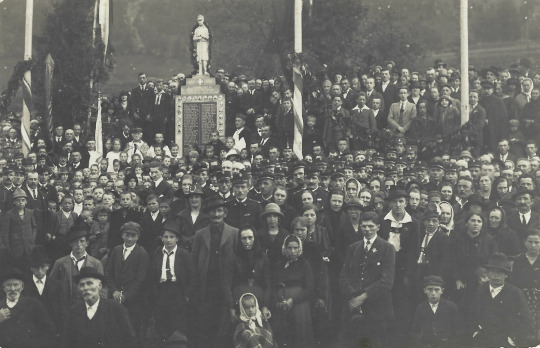
Dovje, Spomenik padlim v 1. vojni
Spomeniki padlim in pogrešanim v prvi svetovni vojni so bili v veliki meri postavljeni na bojnih poljanah in grobiščih, ki so slovela po velikem številu žrtev. Poleg teh krajev pa so v letih po koncu vojne začeli postavljati spomenike in spominska obeležja tudi v krajih od koder so bile žrtve doma. Na naših tleh je eden takšnih spomenikov nastal v kraju Dovje-Mojstrana, kjer so v letu 1925 v bližini župnijske cerkve sv. Mihaela občani občine Dovje-Mojstrana postavili marmorno spominsko ploščo s šestdesetimi imeni padlih in pogrešanih. Ob imenih vojakov so tudi zapisana okrajšana imena krajev ( Mojstrana, Dovje, Belca, Radovna, Podkuže) od koder so bili vojaki doma. Pri nekaterih imenih vojakov so v ovalu tudi njihove fotografije. Nad spominsko ploščo je bil prvotno kip vojaka v uniformi 17. kranjskega pešpolka, ki pa je v jeseni 1938 doživel žalostno usodo. Neznani storilci so ga vrgli s podstavka, mu odbili glavo in ga zakotalili v Savo. Spominska plošča je ob tem dogodku ostala nepoškodovana. Kip je danes obnovljen. Del spominskega obeležja sta tudi dve kamniti topovski granati. Avtor spomenika je bil kamnosek France Cengle iz Radovljice, ki je pred tem izdelal spomenik v Kamni Gorici. Iz neposlane razglednice je moč razbrati, da se je odkritja spomenika udeležila velika množica ljudi. Slovesen blagoslov je opravil Jakob Aljaž (1845-1927), duhovni svetnik in župnik na Dovjem. Slavnostni govor je imel Franc Bonač (1885-1935) vojni kurat in tajnik Zveze Bojevnikov, ki je bil ob tej priložnosti pogost govorec.
2 notes
·
View notes
Text

28th March >> Fr. Martin's Reflections / Homilies on Today's Mass Readings (Inc. John 13:1-15) for Holy Thursday (B) : ‘He began to wash his disciples’ feet’.
Holy Thursday
Gospel (Except USA) John 13:1-15 Now he showed how perfect his love was.
It was before the festival of the Passover, and Jesus knew that the hour had come for him to pass from this world to the Father. He had always loved those who were his in the world, but now he showed how perfect his love was.
They were at supper, and the devil had already put it into the mind of Judas Iscariot son of Simon, to betray him. Jesus knew that the Father had put everything into his hands, and that he had come from God and was returning to God, and he got up from table, removed his outer garment and, taking a towel, wrapped it round his waist; he then poured water into a basin and began to wash the disciples’ feet and to wipe them with the towel he was wearing. He came to Simon Peter, who said to him, ‘Lord, are you going to wash my feet?’ Jesus answered, ‘At the moment you do not know what I am doing, but later you will understand.’ ‘Never!’ said Peter ‘You shall never wash my feet.’ Jesus replied, ‘If I do not wash you, you can have nothing in common with me.’ ‘Then, Lord,’ said Simon Peter ‘not only my feet, but my hands and my head as well!’ Jesus said, ‘No one who has taken a bath needs washing, he is clean all over. You too are clean, though not all of you are.’ He knew who was going to betray him, that was why he said, ‘though not all of you are.’
When he had washed their feet and put on his clothes again he went back to the table. ‘Do you understand’ he said ‘what I have done to you? You call me Master and Lord, and rightly; so I am. If I, then, the Lord and Master, have washed your feet, you should wash each other’s feet. I have given you an example so that you may copy what I have done to you.’
Gospel (USA) John 13:1–15 Jesus loved them to the end.
Before the feast of Passover, Jesus knew that his hour had come to pass from this world to the Father. He loved his own in the world and he loved them to the end. The devil had already induced Judas, son of Simon the Iscariot, to hand him over. So, during supper, fully aware that the Father had put everything into his power and that he had come from God and was returning to God, he rose from supper and took off his outer garments. He took a towel and tied it around his waist. Then he poured water into a basin and began to wash the disciples’ feet and dry them with the towel around his waist. He came to Simon Peter, who said to him, “Master, are you going to wash my feet?” Jesus answered and said to him, “What I am doing, you do not understand now, but you will understand later.” Peter said to him, “You will never wash my feet.” Jesus answered him, “Unless I wash you, you will have no inheritance with me.” Simon Peter said to him, “Master, then not only my feet, but my hands and head as well.” Jesus said to him, “Whoever has bathed has no need except to have his feet washed, for he is clean all over; so you are clean, but not all.” For he knew who would betray him; for this reason, he said, “Not all of you are clean.”
So when he had washed their feet and put his garments back on and reclined at table again, he said to them, “Do you realize what I have done for you? You call me ‘teacher’ and ‘master,’ and rightly so, for indeed I am. If I, therefore, the master and teacher, have washed your feet, you ought to wash one another’s feet. I have given you a model to follow, so that as I have done for you, you should also do.”
Reflections (4)
(i) Holy Thursday
I have a print of a painting of the scene in this evening’s gospel reading of Jesus washing the feet of his disciples at the last supper. It is by a German artist named Sieger Koder who died nine years ago at the age of 90. He was a prisoner of war during World War II. Having worked as an artist for many years, he went on to study for the priesthood and was ordained in his late forties. He combined his vocation as a priest with his work as an artist, and continued painting well into his retirement. The focus of his painting of this evening’s gospel reading is on Jesus and Peter. A kneeling Jesus is bent over a bowl of dirty looking water and the seated Peter has his feet in the water. Peter has his left hand raised in protest at Jesus wanting to wash his feet, ‘Never’, he says in our gospel reading, ‘you shall never wash my feet’. He is outraged that Jesus is performing for him a task that would normally be reserved to slaves. Peter’s strong protest is matched by Jesus’ strong insistence, ‘If I do not wash you, you can have nothing in common with me’. Peter’s eventual surrender to Jesus’ desire to wash his feet is depicted in the painting by Peter’s right hand which is at rest on Jesus’ shoulder. The artist doesn’t show the face of Jesus directly, only his back, but his face is reflected in the dirty water where Peter’s feet rest.
A painting that comes from the soul of an artist can speak more powerfully than words alone. Peter felt unworthy of this menial expression of Jesus’s service of him. We can all be like Peter. We feel unworthy of the Lord’s loving service. We struggle to receive the Lord’s gift of himself. Sometimes we have to learn like Peter to let go to the Lord and to allow him to serve us in the way he chooses. It is was difficult for Peter to accept that Jesus, his Lord and Master, could relate to him like a slave. No doubt Peter would have said, ‘It is your feet I should be washing’. Yet, this is the way that the Lord has chosen to serve us all. He gets down on his knees for us to demonstrate the depth of his love for us. What Jesus did at the last supper anticipated what he would do the following day on Calvary. At the supper, he laid down his garments to wash his disciples’ feet. On Calvary, he laid down his life to wash all of humanity in his love. Just as he humbled himself to wash the feet of his disciples, so he would humble himself even more when he submitted to death on a cross for each us all. The Lord who emptied himself to wash the feet of his disciples is the same Lord who emptied himself on the cross for each one of us. We can each say with Saint Paul, ‘I live by faith in the Son of God who loved me and gave himself for me’. Like Peter, we can struggle to accept the way the Lord empties himself, humbles himself, in love for me personally. We can have our own way of saying Peter’s ‘Never’, ‘not me’. Yet, the Lord would be as insistent with us as he was with Peter, refusing to take our ‘Never’ for an answer.
The Lord who washed the feet of his disciples at the last supper also did something else, as Saint Paul reminds us in the second reading. He gave himself, his body and blood, to his disciples, under the form of bread and wine. Like the washing of his disciples’ feet, this too anticipated what he would do the following day on Calvary. On the cross he gave his body and his blood as an expression of his love for us; he emptied himself for us. At the last supper, he brought forward this self-emptying love by giving himself, his body and blood, under the form of the bread and wine on the table. Just as he insisted that his disciples allow him to wash their feet, he now insisted that they eat the bread and drink the wine, which he identified with himself. They are to receive this gift of himself. His command to ‘do this as a memorial of me’ meant that the Last Supper was also the beginning of what we call the Eucharist. At every Eucharist, the Lord gives himself to us under the form of bread and wine. The Lord’s self-emptying love, expressed fully on Calvary, is present to us at every Eucharist, as it was present at the Last Supper. When we take the bread of the Eucharist and eat it, we are entering into communion with the Lord’s self-giving love. We are allowing ourselves to be caught up into the Lord’s servant love for us, and, in entering into communion with the Lord, we also enter into communion with one another.
Having received the Lord’s love at the Eucharist, we are then sent out to share that love with one another, to give as we have received. We are to wash each other’s feet, whatever form that might take. Such acts of self-giving love are to be found throughout the homes of this parish. The spirit of Holy Thursday is alive among us, and for this we give thanks.
And/Or
(ii) Holy Thursday
We can learn a lot from the way that children express their faith. Those of us who are adults tend to think of ourselves as the children’s teachers. Yet, they can teach us a lot, especially when it comes to our relationship with God. Their spontaneous openness to the Lord when they are very young can touch our own faith and help to deepen it.
On one occasion in the gospel story the disciples of Jesus were trying to block parents from bringing their children to Jesus. They were clearly of the view that children should be neither seen nor heard. The evangelist tells us that Jesus was indignant with his disciples and said to them, ‘Let the children come to me; do not stop them… Truly I tell you, whoever does not receive the kingdom of God like a little child will not enter it’. Jesus was saying to his disciples – ‘Look at the children and learn from them. They have a lot to teach you about receiving the gift of the kingdom of God’. Children know how to receive the gift of God. Their openness to the gift of God can help to open up all of our hearts to the Lord’s presence and call in our own lives.
The meaning of Holy Thursday could be summed up in the word ‘gift’. At the last supper Jesus gave his disciples the gift of himself in loving service. He did this in two ways. Firstly, he washed their feet. This was a menial task that servants in a household usually performed. In washing the feet of his disciples, Jesus was showing that he was their servant, our servant. We usually think of Jesus as Lord. ‘Jesus is Lord’ is one of the great Christian confessions. How can a Lord do the work of a servant? This was why Peter objected to what Jesus was doing – ‘you will never wash my feet’. Peter, unlike children, could not receive the gift of Jesus’ service. However, Jesus was showing by this gesture that he exercises his lordship not by ruling and dominating but by serving, by giving the gift of himself. It was by giving the gift of himself to us that he became our Lord. In laying down his garments to wash the feet of his disciples, Jesus was anticipating the greater gift he would give them the following day, when he would lay down his life for them and for us on the cross.
The second way that Jesus gave the gift of himself to his disciples at that last supper was when he gave himself to them under the form of bread and wine. Taking bread, he blessed it and gave it to them saying, ‘Take and eat’. Taking a cup of wine, he blessed it and gave it to them and said, ‘Take and drink’. Like the washing of their feet, that gift of himself under the form of bread and wine anticipated the gift of himself that he would make to them and to all of us the following day on the cross. In allowing Jesus to wash their feet and in taking the bread and the cup, the disciples were receiving the gift of himself that Jesus would give them from the cross. In receiving that gift they would never be the same again. They would now have to give as they had received.
Jesus intended that what happened at the last supper would be the shape of the church forever, the shape of our own lives. The last supper was not just a once off event. When he had washed feet of his disciples, he said to them, ‘Do as I have done… love one another as I have loved you’. As he has served us, we are to serve one another, and in serving one another, the Lord continues to serve us in and through each other. In giving the bread and cup to his disciples he said to them, ‘Do this in memory of me’. We are to repeat the words and actions over the bread and cup, and in doing that the Lord will continue to give himself to us under the form of bread and wine. This is what we do when we celebrate the Eucharist. Both of those commands that Jesus gave at the last supper are important: ‘Love one another as I have loved you’, and ‘Do this in memory of me’. A life of service and the celebration of the Eucharist are both at the heart of what it means to be the Lord’s followers. At the Eucharist we receive again the Lord’s gift of himself that he made to us on the cross, and in receiving that gift we find the strength to live faithfully the call to love one another as he has loved us.
And/Or
(iii) Holy Thursday
All four gospels agree that Jesus was crucified on a Friday, the day before the Jewish Sabbath. All of the gospels agree that, on the previous evening, Thursday evening, Jesus had a final meal with his disciples. We call that meal the Last Supper. We commemorate the Last Supper every time we celebrate Mass. However, at this Mass which we celebrate on Holy Thursday evening, we commemorate the Last Supper in a very focused way. That is why only this Holy Thursday Mass is called the Evening Mass of the Lord’s Supper.
The earliest reference to the Last Supper, the oldest reference, is to be found in this evening’s second reading. In that reading, Paul reminds the church in Corinth of the tradition about that Last Supper that he had earlier passed on to them by word of mouth, when he first preached the gospel among them. ‘This is what I received from the Lord, and in turn passed on to you’. The memory of that Last Supper was one of the most precious traditions of the church. It was a precious tradition because of what happened at that Last Supper, what Jesus did. However, in that reading, before describing what Jesus did at the Last Supper, Paul refers to what was done to Jesus. Paul initially refers to that evening as ‘the night he (Jesus) was betrayed’. This was the dark side of that evening. One of Jesus’ closest disciples, one of the Twelve, one of that group in whom Jesus had invested so much of himself betrayed Jesus that evening to his enemies. Yet, the shadow that was cast over that evening did not define it. It was not defined in the memory of the early church by an Judas’ act of betrayal. It was defined by Jesus’ act of love. It is that act of love that we commemorate and celebrate this Holy Thursday evening.
What was that act of love? There were indeed two acts of love that defined that evening. One is described by the evangelist John in this evening’s gospel reading and the other is described by the apostle Paul in this evening’s second reading. The first of Jesus’ acts of love we are about to re-enact in a few moments. Very often, in the culture of Jesus, a host would give his guests a bowl of water to wash the dust of the streets and paths off their feet. It was considered an fitting act of hospitality. It would never happen that the host himself would wash the feet of his guests. If the host was wealthy, he might get one of his slaves to wash their feet, but he would never do it himself. What Jesus did at that Last Supper in washing the feet of his guests, his disciples, was something completely out of the ordinary. It was totally unconventional. Peter’s reaction to what Jesus was doing was perfectly understandable, ‘You shall never wash my feet’. Yet, Jesus’ insistence was stronger than Peter’s resistance. This was how Jesus wanted to relate to his disciples. He wanted to serve them in this very menial way, as it would have been understood then. He wanted to empty himself in their service. He was treating them with great respect and dignity. He was giving himself in love for them, for all of them, Judas included. We have to see those disciples as representing all future disciples, all of us here this evening. The way Jesus relates to them is how he wants to relate to us all. The Lord’s self-emptying love embraces us all. In laying aside his garment to empty himself in love for his disciples, Jesus was anticipating what he would do on the following afternoon. Then, his garments would be taken from him by his enemies and Jesus would empty himself in love on the cross for all of humanity. This evening we celebrate the extent to which Jesus gave of himself for us all, at the Last Supper and on the cross. We are invited to do what Peter was so reluctant to do, to receive the Lord’s love in the way the Lord wanted to express it. Having received that love, we are then invited to share that love with each other. In washing the feet of his disciples, Jesus was showing us how we are to relate to one another. We are to approach each other with the same respect for the dignity of the other that Jesus showed on that evening.
The second action of Jesus on the evening of the Last Supper is described by Saint Paul in the second reading and by the other three evangelists, Matthew, Mark and Luke. He took bread, thanked God for it, broke it and gave it to his disciples, saying, ‘This is my body, which is for you’. He took a cup of wine, thanked God for it, and gave it to his disciples, saying, ‘This cup is the new covenant in my blood’. Jesus identified himself, his body and blood, with the bread and wine. Just as he gave himself in love to his disciples by washing their feet, he now gave himself in love to them by giving himself to them under the form of bread and wine. Just as in washing their feet, he anticipated the gift of himself on would make on the cross, so in giving them his body and blood under the form of bread and wine he was again symbolically anticipating the gift he would make of himself on the cross. The early church repeated this second action of Jesus with his words every time they gathered to celebrate the Eucharist. At every Eucharist, the love which Jesus gave expression to by his actions at the Last Supper and most fully on the cross is present again to us all. As Paul says at the end of that reading, ‘Every time you eat this bread and drink this cup, you are proclaiming the Lord’s death’, and the love which the death expressed. At every Eucharist, we are invited to receive the Lord’s love and we are called by the Lord to bring that love we have received to each other. At every Eucharist, the Lord sends us out with the words, ‘Love one another, as I have loved you’.
And/Or
(iv) Holy Thursday
All four gospels agree that Jesus was crucified on a Friday, the day before the Jewish Sabbath. All of the gospels agree that, on the previous evening, Jesus had a final meal with his disciples. We call that meal the Last Supper. We commemorate the Last Supper every time we celebrate Mass. However, at this Mass which we celebrate on Holy Thursday evening, we commemorate the Last Supper in a very focused way. That is why only this Holy Thursday Mass is called the Evening Mass of the Lord’s Supper.
The earliest reference to the Last Supper is to be found in this evening’s second reading. In that reading, Paul reminds the church in Corinth of the tradition about that Last Supper that he had earlier passed on to them by word of mouth, when he first preached the gospel among them. ‘This is what I received from the Lord, and in turn passed on to you’. The memory of that Last Supper was one of the most precious traditions of the church. It was a precious tradition because of what happened at that Last Supper, what Jesus did. However, in that reading, before describing what Jesus did at the Last Supper, Paul refers to what was done to Jesus. It was ‘the night he (Jesus) was betrayed’. This was the dark side of that evening. One of Jesus’ closest disciples betrayed Jesus that evening to his enemies. Yet, this shadow that was cast over that evening did not define it. It was defined by Jesus’ act of love. It is that act of love that we commemorate and celebrate this Holy Thursday evening.
There were indeed two acts of love that defined that evening. One is described by the evangelist John in this evening’s gospel reading and the other is described by the apostle Paul in this evening’s second reading. Very often, in the culture of Jesus, a host would give his guests a bowl of water to wash the dust of the streets and paths off their feet. It was considered a fitting act of hospitality. If the host was wealthy, he might get one of his slaves to wash their feet, but he would never do it himself. What Jesus did at that Last Supper in washing the feet of his guests, his disciples, was totally unconventional. Peter’s reaction to what Jesus was doing was perfectly understandable, ‘You shall never wash my feet’. Yet, Jesus’ insistence was stronger than Peter’s resistance. This was how Jesus wanted to relate to his disciples. He wanted to serve them in this very menial way. He wanted to empty himself in their service. He was treating them with great respect and dignity. He was giving himself in love for all of them, Judas included. The way Jesus relates to them is how he wants to relate to us all. The Lord’s self-emptying love embraces us all. In laying aside his garment to empty himself in love for his disciples, Jesus was anticipating what he would do on the following afternoon. Then, his garments would be taken from him by his enemies and Jesus would empty himself in love on the cross for all of humanity. This evening we celebrate the extent to which Jesus gave of himself for us all. We are invited to do what Peter was so reluctant to do, to receive the Lord’s love in the way the Lord wanted to express it. Having received that love, we are then invited to share that love with each other. We are to approach each other with the same respect for the dignity of the other that Jesus showed on that evening.
The second action of Jesus on the evening of the Last Supper is described by Saint Paul in the second reading and by the other three evangelists, Matthew, Mark and Luke. He took bread, thanked God for it, broke it and gave it to his disciples, saying, ‘This is my body, which is for you’. He took a cup of wine, thanked God for it, and gave it to his disciples, saying, ‘This cup is the new covenant in my blood’. Just as he gave himself in love to his disciples by washing their feet, he now gave himself in love to them under the form of bread and wine. Just as in washing their feet, he anticipated the gift of himself he would make on the cross, so in giving them his body and blood under the form of bread and wine he was symbolically anticipating the gift he would make of himself on the cross. The early church repeated this second action of Jesus with his words every time they gathered to celebrate the Eucharist. At every Eucharist, the love which Jesus gave expression to by his actions at the Last Supper and most fully on the cross is present again to us all. As Paul says at the end of that reading, ‘Every time you eat this bread and drink this cup, you are proclaiming the Lord’s death’, and the love which the death expressed. At every Eucharist, we are invited to receive the Lord’s love and we are called by the Lord to bring that love we have received to each other. At every Eucharist, the Lord sends us out with the words, ‘Love one another, as I have loved you’.
Fr. Martin Hogan.
4 notes
·
View notes
Text

28th March - ‘He began to wash his disciples’ feet’, Reflection on the readings for Holy Thursday (Jn 13:1-15)
Holy Thursday
I have a print of a painting of the scene in this evening’s gospel reading of Jesus washing the feet of his disciples at the last supper. It is by a German artist named Sieger Koder who died nine years ago at the age of 90. He was a prisoner of war during World War II. Having worked as an artist for many years, he went on to study for the priesthood and was ordained in his late forties. He combined his vocation as a priest with his work as an artist, and continued painting well into his retirement. The focus of his painting of this evening’s gospel reading is on Jesus and Peter. A kneeling Jesus is bent over a bowl of dirty looking water and the seated Peter has his feet in the water. Peter has his left hand raised in protest at Jesus wanting to wash his feet, ‘Never’, he says in our gospel reading, ‘you shall never wash my feet’. He is outraged that Jesus is performing for him a task that would normally be reserved to slaves. Peter’s strong protest is matched by Jesus’ strong insistence, ‘If I do not wash you, you can have nothing in common with me’. Peter’s eventual surrender to Jesus’ desire to wash his feet is depicted in the painting by Peter’s right hand which is at rest on Jesus’ shoulder. The artist doesn’t show the face of Jesus directly, only his back, but his face is reflected in the dirty water where Peter’s feet rest.
A painting that comes from the soul of an artist can speak more powerfully than words alone. Peter felt unworthy of this menial expression of Jesus’s service of him. We can all be like Peter. We feel unworthy of the Lord’s loving service. We struggle to receive the Lord’s gift of himself. Sometimes we have to learn like Peter to let go to the Lord and to allow him to serve us in the way he chooses. It is was difficult for Peter to accept that Jesus, his Lord and Master, could relate to him like a slave. No doubt Peter would have said, ‘It is your feet I should be washing’. Yet, this is the way that the Lord has chosen to serve us all. He gets down on his knees for us to demonstrate the depth of his love for us. What Jesus did at the last supper anticipated what he would do the following day on Calvary. At the supper, he laid down his garments to wash his disciples’ feet. On Calvary, he laid down his life to wash all of humanity in his love. Just as he humbled himself to wash the feet of his disciples, so he would humble himself even more when he submitted to death on a cross for each us all. The Lord who emptied himself to wash the feet of his disciples is the same Lord who emptied himself on the cross for each one of us. We can each say with Saint Paul, ‘I live by faith in the Son of God who loved me and gave himself for me’. Like Peter, we can struggle to accept the way the Lord empties himself, humbles himself, in love for me personally. We can have our own way of saying Peter’s ‘Never’, ‘not me’. Yet, the Lord would be as insistent with us as he was with Peter, refusing to take our ‘Never’ for an answer.
The Lord who washed the feet of his disciples at the last supper also did something else, as Saint Paul reminds us in the second reading. He gave himself, his body and blood, to his disciples, under the form of bread and wine. Like the washing of his disciples’ feet, this too anticipated what he would do the following day on Calvary. On the cross he gave his body and his blood as an expression of his love for us; he emptied himself for us. At the last supper, he brought forward this self-emptying love by giving himself, his body and blood, under the form of the bread and wine on the table. Just as he insisted that his disciples allow him to wash their feet, he now insisted that they eat the bread and drink the wine, which he identified with himself. They are to receive this gift of himself. His command to ‘do this as a memorial of me’ meant that the Last Supper was also the beginning of what we call the Eucharist. At every Eucharist, the Lord gives himself to us under the form of bread and wine. The Lord’s self-emptying love, expressed fully on Calvary, is present to us at every Eucharist, as it was present at the Last Supper. When we take the bread of the Eucharist and eat it, we are entering into communion with the Lord’s self-giving love. We are allowing ourselves to be caught up into the Lord’s servant love for us, and, in entering into communion with the Lord, we also enter into communion with one another.
Having received the Lord’s love at the Eucharist, we are then sent out to share that love with one another, to give as we have received. We are to wash each other’s feet, whatever form that might take. Such acts of self-giving love are to be found throughout the homes of this parish. The spirit of Holy Thursday is alive among us, and for this we give thanks.
2 notes
·
View notes
Text
"Živé naj vsi naródi, ki hrepené dočakat dan, ko, koder sonce hodi, prepir iz svéta bo pregnan"
Read it in the original Slovenian here | Listen to the Slovenian National Anthem (with English translation) here | Reblog for a larger sample size!
#closed polls#polls#poetry#poems#poetry polls#poets and writing#tumblr poetry#have you read this#zdravljica#france prešeren#slovenia#slovenian poetry#slovenian national anthem
3 notes
·
View notes
Text

TSV Reichartshausen – Fußball
Ansprechpartner: 1. Vorsitzender Thorsten Koder
Tel.: 0163/4194407
Email: [email protected]
Jugend und Damen
Rückblick Jugend und Damen Saison 2024/2025
Es war ein bisschen eine Saison der verpassten Möglichkeiten. Man war überall vorne mit dabei, aber zu Meisterschaften reichte es leider oftmals nicht. Ausnahme waren unsere B-Junioren, welchen Futsal-Kreismeister wurden sowie die D2-Junioren die ihre Herbststaffel gewannen. Alle anderen verpassten knapp die Meisterschaften sowie den Pokalsieg. Bei den A-, B- und C-Junioren hatte man eine Spielgemeinschaft mit dem TSV Helmstadt und dem TSV Neckarbischofsheim. Die A-Junioren mussten sich nach starker Leistung im Pokalfinale dem VfB Eppingen geschlagen geben. Unsere SG konnte als eine der wenigen im Fußballkreis Sinsheim überhaupt eine A-Jugendmannschaft stellen. Sie belegte einen guten Mittelfeldplatz in der Kreisliga Heidelberg. Sowohl die B- als auch die C-Junioren scheiterten unglücklich im Pokalhalbfinale. In der Runde erreichten beide einen guten zweiten Platz in der Kreisliga. Die beiden 2. Mannschaften in diesen Altersklassen hatten zwar keine vorderen Plätze, aber allein schon das Durchspielen der Runde war hier schon ein großer Erfolg. Und die B2 erreichte sogar den Fairnesspreis in der Kreisliga. Bei den beiden D-Junioren lief es in der Frühjahrsstaffel sehr unglücklich. Zwei Spieltag vor Schluss war man mit beiden Mannschaften noch Tabellenführer. Aufgrund der sehr engen Tabellensituation verlor man diese jedoch durch 2 unnötige Niederlagen am vorletzten Spieltag. Aber trotzdem war gerade unsere D2-Mannschaft sehr erfolgreich, insbesondere da diese nur aus jüngeren Jahrgang bzw. E-Junioren bestand. Bei den E-, F-Junioren sowie den Bambinis wurden in allen Altersklassen Mannschaften gestellt und auch mehrerer Spieltage durchgeführt. Gerade in den letzten Spielen haben unsere Damen gezeigt, was möglich gewesen wäre. Im Endeffekt belegte man einen guten Mittelfeldplatz. Erfreulich war auch, dass in Spielgemeinschaft mit dem TSV Helmstadt wieder eine D-Juniorinnenmannschaft gemeldet werden konnte. Die Mädchen sind mit Eifer dabei und auch der 1. Saisonsieg konnte errungen werden.
Jugend und Damen
Jugendturnier TSV Reichartshausen
Folgende Turniere/Spielfeste geplant:
Samstag, 28.06.25
09:00 – 13:00 Uhr D-Junioren (12 Mannschaften)
10:00 – 12:00 Uhr C-Junioren (5 Mannschaften)
12:30 – 16:30 Uhr E-Junioren (25 Mannschaften)
Sonntag, 29.06.25
10:00 – 15:30 Uhr F-Junioren (33 Mannschaften in 2 Gruppen)
15:30 – 17:30 Uhr Bambinis (24 Mannschaften)
Zu unserem traditionellen Jugendturnier haben sich wieder viele Mannschaften aus mehreren Fußballkreisen angemeldet. Alle Fußballinteressierten sind recht herzlich zum Besuch unseres Jugendturniers eingeladen.
Kuchenspende!!!!!
Im Rahmen unseres Jugendturniers am 28. und 29.06.2025 möchte die Jugendfußballabteilung wieder alle seine Gäste mit einem vielfältigen Kuchenbuffet verwöhnen.
Die Jugendfußballabteilung würde sich daher sehr herzlich über Kuchenspenden freuen. Jeder Beitrag ist willkommen und trägt dazu bei, dass das Jugendturnier ein voller Erfolg wird. Wenn jemand bereit ist, einen Kuchen zu spenden, würde wir uns sehr freuen, wenn ihr euch bis spätestens 23.06.2025 bei Julia Reuter (Tel.: 0176-63112772 oder per E-Mail [email protected]) melden könnt. Bitte nur kurz mitteilen, um welche Art von Kuchen es sich handelt. Bei Rückfragen oder Anmeldung einer Spende steht Julia gerne zur Verfügung. Vielen Dank im Voraus
0 notes
Text
The Gathering (with the Sanhedrin), poem
After his arrest, Jesus was taken to the home of Caiaphas, where the Sanhedrin, the religious council, convened a tribunal to decide his fate. The council was determined to have Jesus crucified.
The Gathering
Behind closed doors we elders, priests and scribes gather in the gloom (liars all). Caiaphas surveys the room, pods a shackled Jesus to the fore and cries, "Bring in the witness!" In march our well-paid spies. And what for? What are we doing here is a question I swat like a housefly. Silent, Jesus stands by as strangers, poorly rehearsed, confusing place and time, recite some dubious crime -
He dines with sinners. He heals on the Sabbath. He makes himself equal with God.
"Yes Yes!" breathes Caiaphas, a mongrel smelling blood. "Tell me. Are you the Son of God?" He licks his lips, hangs the question like a noose. Jesus slips it on. "You say that I am". "Blasphemy! Blasphemy! we shout. And yet, doubt nibbles at my ear. Who is this man, really? And what are we doing here?
From this book: At Jerusalem's Gate: Poems of Easter By Nikki Grimes
+++
Art: Sieger Koder, German artist

0 notes
Text
Ukenummer
Nummeruke.no er en norsk nettside som gir enkel tilgang til informasjon om det norske nummersystemet, inkludert nummersekvenser og koder brukt i ulike sektorer.
norsk kalender 2025
1 note
·
View note
Text
Tilmeld dig Nyhedsbreve og Få Eksklusive Kampagnekoder
Online shopping er blevet en uundværlig del af vores liv, og med det følger jagten på de bedste tilbud og rabatter. En af de bedste måder at få adgang til eksklusive kampagnekoder og rabatter er ved at tilmelde sig nyhedsbreve fra dine yndlingsbutikker. Mange virksomheder tilbyder særlige rabatter og koder kun til deres nyhedsbrevabonnenter, hvilket betyder, at du kan få store besparelser, som ikke nødvendigvis er tilgængelige for alle. I denne artikel vil vi udforske, hvordan du kan drage fordel af at tilmelde dig nyhedsbreve og få adgang til de bedste eksklusive kampagnekoder Online rabatter på OxiDeals.
Hvad Er Eksklusive Kampagnekoder?
Eksklusive kampagnekoder er rabatkoder, som kun er tilgængelige for en bestemt gruppe mennesker, som f.eks. nyhedsbrevabonnenter eller medlemmer af et loyalitetsprogram. Disse koder giver dig mulighed for at få rabatter på dine køb, ofte i form af procentrabatter, gratis fragt eller et fast beløb trukket fra ordren. De er ofte ikke tilgængelige på rabatkodesider eller offentlige platforms.
Virksomheder bruger eksklusive kampagnekoder som en måde at belønne deres kunder og opbygge loyalitet. Hvis du er en del af en virksomheds nyhedsbrev, får du direkte adgang til disse koder, og du er ofte en af de første til at få besked om specielle salg, tilbud og nye produkter.
Fordele Ved at Tilmeld dig Nyhedsbreve
1. Få Tidlig Adgang til Tilbud og Rabatter
En af de største fordele ved at være nyhedsbrevabonnent er, at du får tidlig adgang til specielle tilbud og rabatter, som ikke nødvendigvis deles med den brede offentlighed. Mange butikker sender eksklusive rabatkoder eller salgsinformation til deres abonnenter før de annoncerer dem offentligt på deres hjemmeside eller sociale medier.
For eksempel kan du få en kampagnekode til en weekendudsalg, som kun er tilgængelig for abonnenter i en bestemt periode, eller du kan få besked om en Black Friday-rabat, før tilbuddet er åbent for alle.
2. Modtag Personlige Rabatter og Tilbud
Virksomheder skræddersyr ofte tilbud og rabatter baseret på dine tidligere køb eller præferencer. Hvis du tilmelder dig nyhedsbreve fra dine yndlingsbutikker, kan du få specielle koder, der er tilpasset netop dine interesser. Dette betyder, at rabatterne måske er mere relevante og værdifulde for dig.
For eksempel kan du få en eksklusiv kode, der giver dig en rabat på varer, du ofte køber, eller en kode, der gælder for en kategori af produkter, som du tidligere har vist interesse for.
3. Få Adgang til VIP-Salg og Eksklusive Events
Nogle butikker holder VIP-salg, kun for abonnenter, hvor de tilbyder eksklusive rabatter på udvalgte produkter. Dette kan være en stor fordel, da du kan få adgang til rabatter, som ikke er tilgængelige for resten af køberne. Derudover giver tilmelding til nyhedsbreve dig også mulighed for at få invitationer til særlige events, f.eks. online shopping-events eller før-salgsbegivenheder, hvor du kan shoppe nye kollektioner, før de bliver åbne for offentligheden.
4. Gratis Fragt og Andre Fordele
Mange nyhedsbreve tilbyder også eksklusive fordele som gratis fragt eller gratis retur, hvilket kan være med til at gøre din shoppingoplevelse endnu mere attraktiv. For nogle butikker kan det at være en del af nyhedsbrevslisten give dig adgang til særlige fordele, som gør det nemmere og billigere at handle.
5. Hold Dig Opdateret med Nye Produkter og Lanceringer
At være en del af et nyhedsbrev holder dig ikke kun opdateret på rabatter, men også på nye produktlanceringer og kommende trends. Hvis du er interesseret i et specifikt brand eller en produktkategori, kan du få tidlige opdateringer om nye kollektioner eller restockede varer, der kan være udsolgt hurtigt. Dette giver dig en chance for at sikre dig varer, før de bliver udsolgt.
Sådan Finder Du De Bedste Nyhedsbreve og Kampagnekoder
Nu hvor du ved, hvordan du kan drage fordel af nyhedsbreve, er det vigtigt at vide, hvordan du finder de bedste og mest relevante koder. Her er nogle tips:
1. Tilmeld dig Nyhedsbreve Fra Dine Yndlingsbutikker
Start med at tilmelde dig nyhedsbreve fra de butikker, du handler mest hos. Hvis du allerede har en liste over favoritter, er dette en god måde at sikre dig, at du ikke går glip af eksklusive tilbud. Du kan også søge efter nyhedsbreve fra mindre, nichebutikker, som tilbyder specifikke produkter, du elsker.
2. Brug En Dedikeret E-mailadresse
Da du sandsynligvis vil modtage mange nyhedsbreve, kan det være en god idé at oprette en dedikeret e-mailadresse kun til tilmeldinger. Dette hjælper med at holde din primære indbakke fri for spam og gør det lettere at finde de nyeste tilbud, når du har brug for dem.
3. Tjek Nyhedsbrevenes Velkomstmail
Når du tilmelder dig et nyhedsbrev, får du ofte en velkomstmail. I mange tilfælde indeholder denne mail en eksklusiv rabatkode som tak for tilmeldingen. Sørg for at tjekke denne mail, da den kan give dig en umiddelbar rabat på din første ordre.
4. Vær Opdateret på Salg og Højtider
Butikker tilbyder ofte eksklusive kampagnekoder i forbindelse med særlige højtider som jul, påske eller Black Friday. Tilmeld dig nyhedsbreve før disse perioder, så du får besked om de bedste tilbud i tide.
5. Afmeld Dig Ikke For Hurtigt
Selvom det kan være fristende at afmelde sig et nyhedsbrev efter at have brugt en rabatkode, kan det være en god idé at blive abonnent i et stykke tid. Nogle gange tilbyder butikker bedre koder og tilbud til deres abonnenter over tid, så du kan gå glip af nogle eksklusive rabatter, hvis du afmelder dig for hurtigt.
Er Nyhedsbreve Virkelig Pengene Værd?
Ja, tilmelding til nyhedsbreve kan virkelig være pengene værd, hvis du ønsker at få adgang til eksklusive kampagnekoder og rabatter. Mange butikker tilbyder gode tilbud til deres abonnenter, og du kan få adgang til tidlige rabatter, personlige tilbud og VIP-salg, som ellers ikke ville være tilgængelige. Desuden er det en effektiv måde at holde sig opdateret om nye produkter og kommende lanceringer.
Men vær opmærksom på, at du bør være selektiv med, hvilke nyhedsbreve du tilmelder dig. Det er ikke nødvendigt at tilmelde sig alle nyhedsbreve derude – fokus på de butikker, du virkelig handler hos, for at få de bedste og mest relevante tilbud.
Afslutning
Tilmelding til nyhedsbreve er en enkel og effektiv måde at få adgang til eksklusive kampagnekoder og rabatter, der kan hjælpe dig med at spare penge på dine online køb. Ved at udnytte disse koder kan du få store besparelser, tidlig adgang til tilbud og endda specielle VIP-fordele. Så næste gang du handler online, skal du ikke glemme at tjekke, om der er en nyhedsbrevsabonnement, der kan give dig endnu bedre tilbud!
0 notes
Text
beseda dne: krap
etimologija: praslovansko *kőrpъ in v nekakšni povezavi z germanskimi jeziki (starovisokonemško karp(f)o, nemško Karpfen, vse v istem pomenu). Iz neznanega germanskega jezika tudi v latinščino (carpa), od koder so menda angleži besedo eventualno prevzeli prek francoščine. Kaj več pa na žalost ni znano. Snoj ponuja in hkrati zavrača oz. pove, da je malo verjetno, da bi prišla iz indoevropskega *k(u̯)oh1pro-, prvotno "napihnjen".
Viri:
Digitales Wörterbuch der deutschen Sprache, s. v. "Karpfen", avtor Wolfgang Pfeifer, obiskano 30. 5. 2025, https://www.dwds.de/wb/etymwb/Karpfen
Oxford English Dictionary, s. v. "carp", obiskano 30. 5. 2025, https://www.oed.com/dictionary/carp_n1?tab=etymology#9974813 :

Slovenski etimološki slovar, s. v. "krȁp1", obiskano 30. 5. 2025, https://www.fran.si/193/marko-snoj-slovenski-etimoloski-slovar/4287980/krp
Wiktionary, s. v. "carp", obiskano 30. 5. 2025, https://en.wiktionary.org/wiki/carp
Wiktionary, s. v. "carpa", obiskano 30. 5. 2025, https://en.wiktionary.org/wiki/carpa#Latin
4 notes
·
View notes